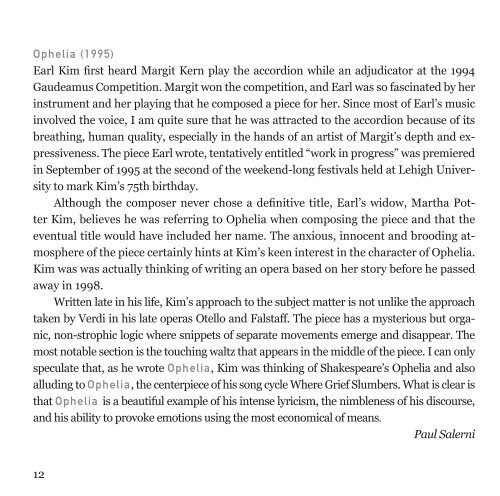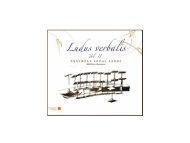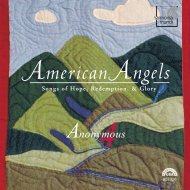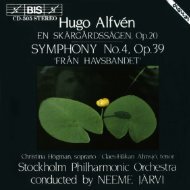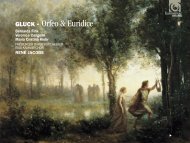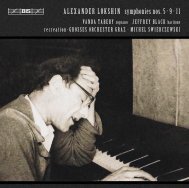Mirror – New Music for Accordion - eClassical
Mirror – New Music for Accordion - eClassical
Mirror – New Music for Accordion - eClassical
Erfolgreiche ePaper selbst erstellen
Machen Sie aus Ihren PDF Publikationen ein blätterbares Flipbook mit unserer einzigartigen Google optimierten e-Paper Software.
Ophelia (1995)<br />
Earl Kim first heard Margit Kern play the accordion while an adjudicator at the 1994<br />
Gaudeamus Competition. Margit won the competition, and Earl was so fascinated by her<br />
instrument and her playing that he composed a piece <strong>for</strong> her. Since most of Earl’s music<br />
involved the voice, I am quite sure that he was attracted to the accordion because of its<br />
breathing, human quality, especially in the hands of an artist of Margit’s depth and expressiveness.<br />
The piece Earl wrote, tentatively entitled “work in progress” was premiered<br />
in September of 1995 at the second of the weekend-long festivals held at Lehigh University<br />
to mark Kim’s 75th birthday.<br />
Although the composer never chose a definitive title, Earl’s widow, Martha Potter<br />
Kim, believes he was referring to Ophelia when composing the piece and that the<br />
eventual title would have included her name. The anxious, innocent and brooding atmosphere<br />
of the piece certainly hints at Kim’s keen interest in the character of Ophelia.<br />
Kim was was actually thinking of writing an opera based on her story be<strong>for</strong>e he passed<br />
away in 1998.<br />
Written late in his life, Kim’s approach to the subject matter is not unlike the approach<br />
taken by Verdi in his late operas Otello and Falstaff. The piece has a mysterious but organic,<br />
non-strophic logic where snippets of separate movements emerge and disappear. The<br />
most notable section is the touching waltz that appears in the middle of the piece. I can only<br />
speculate that, as he wrote Ophelia, Kim was thinking of Shakespeare’s Ophelia and also<br />
alluding to Ophelia, the centerpiece of his song cycle Where Grief Slumbers. What is clear is<br />
that Ophelia is a beautiful example of his intense lyricism, the nimbleness of his discourse,<br />
and his ability to provoke emotions using the most economical of means.<br />
Paul Salerni<br />
Earl Kim was born in 1920 as the third son of Korean immigrants to the US. He studied<br />
at City College Los Angele, UCLA and Harvard University. His teachers were Arnold<br />
Schönberg, Ernst Bloch, and Roger Sessions. He received commissions from the Fromm<br />
Foundation, the Koussevitzky Foundation and the Naumburg Foundation, the University of<br />
Chicago, Boston University, as well as from various ensembles. His work was also supported<br />
through grants from Ingram Merrill, the Guggenheim Foundation, and from the National<br />
Endowment <strong>for</strong> the Arts. He won the Prix de Paris, the National Institute of Arts and Letters<br />
Award, the Brandeis Creative Arts Medal and the Mark Horblitt Award of the Boston Symphony.<br />
Earl Kim was composer-in-residence at Princeton, the Marlboro <strong>Music</strong> Festival, and<br />
at the Dartmouth, Tanglewood, Cape and Islands and Aspen <strong>Music</strong> Festivals. In addition<br />
to his work as a teacher and composer, he also per<strong>for</strong>med as a pianist and conductor. Earl<br />
Kim co-founded Artists Against Nuclear Arms. He took a special interest in music theater,<br />
especially in works based on the texts of Samuel Beckett. Earl Kim died in 1998.<br />
UND ACHT (AND EIGHT)<br />
Für Akkordeon und Zuspiel<br />
is part of a loose group of works bearing titles taken from a line of Goethe’s Hexen-Einmaleins<br />
spell in Faust I. Each piece in this series is dedicated to the number from the title<br />
which, in turn, influences the respective composition in a very different way. The scoring<br />
of the pieces and the work’s conception, which is closely oriented to the instruments, vary<br />
widely from piece to piece.<br />
Transpositions are used in the recorded portion of UND ACHT. Short sections of the piece<br />
itself were recorded and then played slowly, accelerated or transposed while still played<br />
12 13


